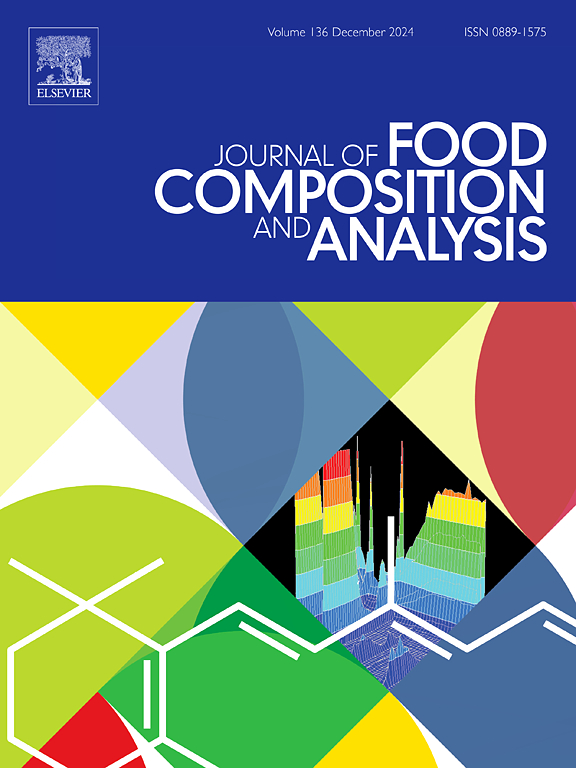建立一种快速检测动物组织和牛奶中杆菌肽的超灵敏间接竞争化学发光酶联免疫分析法
IF 4.6
2区 农林科学
Q2 CHEMISTRY, APPLIED
引用次数: 0
摘要
近年来,由于杆菌肽(bacitracin, BAC)的不科学、不合理使用,动物源性细菌的耐药性不断增加,对动物源性食品安全和公共卫生安全构成威胁。因此,迫切需要开发一种快速、灵敏的BAC检测方法。本研究以bac -卵清蛋白为包被抗原,以小鼠单克隆抗体为检测抗体,并对其工作体系进行了优化。建立了间接竞争化学发光酶免疫分析法(ic-CLEIA)检测BAC的方法。在最佳条件下,该方法半数最大抑菌浓度为0.10 ng/mL,检测线性范围为0.05 ~ 2.19 ng/mL。该方法的检出限比最大残留限低500倍以上。样品回收率为78.7% % ~ 93.7 %,81.3 % ~ 96.7 %。法内、法间变异系数均小于15 %,精密度好,与5种杆菌肽类似物无交叉反应。同时,HPLC也验证了该方法的可靠性。该方法为实际动物性食品中BAC残留的筛选提供了一种方便、准确、快速的方法。本文章由计算机程序翻译,如有差异,请以英文原文为准。
Development of an ultrasensitive indirect competitive chemiluminescent enzyme-linked immunoassay for the rapid detection of bacitracin in animal tissues and milk
In recent years, due to the unscientific and irrational use of bacitracin (BAC), the drug resistance of animal-derived bacteria has continued to increase, posing a threat to animal-derived food safety and public health safety. Therefore, there is an urgent need to develop a rapid and sensitive BAC assay. In this study, BAC-ovalbumin was used as the coated antigen, mouse monoclonal antibody was used as the detection antibody, and the working system was optimized. An indirect competitive chemiluminescent enzyme immunoassay (ic-CLEIA) for the detection of BAC was established. Under the optimal conditions, the half maximal inhibitory concentration of the method was 0.10 ng/mL, and the linear range of detection was 0.05–2.19 ng/mL. Limit of detection of the method was at least 500 times lower than the maximum residue limits. The sample spike recovery experiment revealed that the recovery rates for animal tissue and milk were 78.7 %–93.7 % and 81.3 %–96.7 %, respectively. The intra-assay and interassay coefficients of variation were all less than 15 %, with good precision and no cross-reaction with five bacitracin analogs. At the same time, HPLC also verified the reliability of the method. This method provides a convenient, accurate and rapid means of screening BAC residues in actual animal-derived foods.
求助全文
通过发布文献求助,成功后即可免费获取论文全文。
去求助
来源期刊

Journal of Food Composition and Analysis
工程技术-食品科技
CiteScore
6.20
自引率
11.60%
发文量
601
审稿时长
53 days
期刊介绍:
The Journal of Food Composition and Analysis publishes manuscripts on scientific aspects of data on the chemical composition of human foods, with particular emphasis on actual data on composition of foods; analytical methods; studies on the manipulation, storage, distribution and use of food composition data; and studies on the statistics, use and distribution of such data and data systems. The Journal''s basis is nutrient composition, with increasing emphasis on bioactive non-nutrient and anti-nutrient components. Papers must provide sufficient description of the food samples, analytical methods, quality control procedures and statistical treatments of the data to permit the end users of the food composition data to evaluate the appropriateness of such data in their projects.
The Journal does not publish papers on: microbiological compounds; sensory quality; aromatics/volatiles in food and wine; essential oils; organoleptic characteristics of food; physical properties; or clinical papers and pharmacology-related papers.
 求助内容:
求助内容: 应助结果提醒方式:
应助结果提醒方式:


